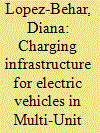|
|
|
Sort Order |
|
|
|
Items / Page
|
|
|
|
|
|
|
| Srl | Item |
| 1 |
ID:
163547


|
|
|
|
|
| Summary/Abstract |
Achieving meaningful reductions in greenhouse gas emissions from the global transportation sector will rely on a large-scale transition to electric vehicles (EVs). Many governments aim to encourage the uptake of EVs in cities, because urban areas are well suited to EV driving ranges and stand to benefit hugely from reduced local emissions. In the Canadian province of British Columbia (BC), where clean renewable electricity sourcing makes EV deployment an attractive proposition, over a quarter of residents live in Multi-Unit Residential Buildings (MURBs), most of which are not equipped with EV charging infrastructure. In a related study, Lopez-Behar et al. (accepted) explored the challenges and decision-making processes involved in the installation of EV charging infrastructure in MURBs in BC, from the perspective of different stakeholders. Here, we build on those findings to map out and analyze feedback loops within this system using a Causal Loop Diagram (CLD). We then present potential demand-focused policy interventions to address the issues raised by our modelling results, grouped into three categories: financial/fiscal, regulatory and information/awareness measures. Financial/fiscal policy measures include creating incentives for EV owners and extending them to the building owners, and programs to incentivize and provide financial aid for building owners to develop building retrofit plans. Regulatory policy measures include addressing the rights and obligations of the stakeholders and making mandatory the installation of charging stations in new MURBs. Information/awareness policy measures include expanding the existing guidelines and informing the development of a long-term EV charging infrastructure plan. Our policy recommendations are designed to inform the interventions of municipal and provincial governments in BC, but could also be relevant to many urban EV markets worldwide.
|
|
|
|
|
|
|
|
|
|
|
|
|
|
|
|
| 2 |
ID:
125597


|
|
|
|
|
| Publication |
2013.
|
| Summary/Abstract |
This paper presents a utility-based and a regret-based model of consumer preferences for alternative fuel vehicles, based on a large-scale stated choice-experiment held among company car leasers in The Netherlands. Estimation and application of random utility maximization and random regret minimization discrete choice models shows that while the two models achieve almost identical fit with the data and differ only marginally in terms of predictive ability, they generate rather different choice probability-simulations and policy implications. The most eye-catching difference between the two models is that the random regret minimization model accommodates a compromise-effect, as it assigns relatively high choice probabilities to alternative fuel vehicles that perform reasonably well on each dimension instead of having a strong performance on some dimensions and a poor performance on others.
|
|
|
|
|
|
|
|
|
|
|
|
|
|
|
|
| 3 |
ID:
096112


|
|
|
|
|
| Publication |
2010.
|
| Summary/Abstract |
To reduce dependence on foreign sources of energy, address climate change, and improve environmental quality, the US government has established a goal of reducing petroleum fuel use in its federal agencies. To this end, the government requires its agencies to purchase alternative fuel vehicles, use alternative fuel, and adopt other strategies to reduce petroleum consumption. Compliance with these requirements, while important, creates challenges for federal fleet managers who oversee large, geographically dispersed fleets. In this study, a group of 25 experienced federal fleet managers participated in a pilot study using a structured methodology for developing strategies to comply with fleet requirements while using agency resources as efficiently as possible. Multi-criteria decision making (MCDM) methods were used to identify and quantify agency priorities in combination with a linear programming model to optimize the purchase of fleet vehicles. The method was successful in quantifying tradeoffs and decreasing the amount of time required to develop fleet management strategies. As such, it is recommended to federal agencies as a standard tool for the development of these strategies in the future.
|
|
|
|
|
|
|
|
|
|
|
|
|
|
|
|
| 4 |
ID:
169752


|
|
|
|
|
| Summary/Abstract |
The transportation sector is responsible for nearly a quarter of greenhouse gases emissions (GHG); thus, incisive policies are necessary to mitigate the sector’s effect on climate change. Promoting alternative fuel vehicles (AFV) is an essential strategy to reduce GHG emissions in the short term. Here, we study the effects of governmental incentives on the diffusion of ethanol and flex-fuel vehicle technologies in Brazil. We use a multi-generation diffusion model which assumes that new technologies introduce fresh market potential for adopters as well as upgraders from established technologies. Our analysis indicates that tax rates affected the adoption of both gasoline and ethanol technology, but for flex vehicles, the effect of taxation is not significant. The effect of fuel price shocks during the 1990s meant that the introduction of ethanol technology made no significant impact on market potential and a negative word-of-mouth effect contributed to the technology’s failure. In contrast, the introduction of flex technology led to almost a doubling of total market potential. As policy suggestions, we emphasise the importance of tax reduction in addition to promoting versatile technologies, which insulate consumers against price fluctuations.
|
|
|
|
|
|
|
|
|
|
|
|
|
|
|
|
|
|
|
|
|